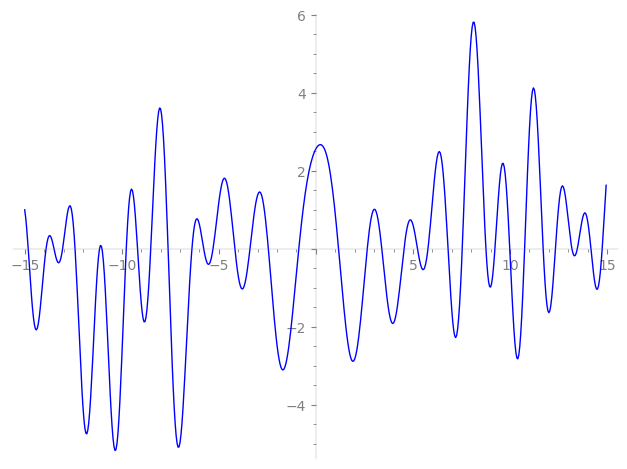| L(s) = 1 | + 1.15·2-s − 0.654·4-s + 1.65·5-s + 0.0488i·7-s − 3.07·8-s + 1.91·10-s + (−1.85 − 2.74i)11-s + 3.48·13-s + 0.0566i·14-s − 2.26·16-s + 4.74i·17-s + (3.79 − 2.13i)19-s − 1.08·20-s + (−2.15 − 3.18i)22-s + 9.20·23-s + ⋯ |
| L(s) = 1 | + 0.820·2-s − 0.327·4-s + 0.740·5-s + 0.0184i·7-s − 1.08·8-s + 0.606·10-s + (−0.559 − 0.828i)11-s + 0.966·13-s + 0.0151i·14-s − 0.565·16-s + 1.15i·17-s + (0.871 − 0.489i)19-s − 0.242·20-s + (−0.458 − 0.679i)22-s + 1.91·23-s + ⋯ |
Λ(s)=(=(1881s/2ΓC(s)L(s)(0.893+0.448i)Λ(2−s)
Λ(s)=(=(1881s/2ΓC(s+1/2)L(s)(0.893+0.448i)Λ(1−s)
| Degree: |
2 |
| Conductor: |
1881
= 32⋅11⋅19
|
| Sign: |
0.893+0.448i
|
| Analytic conductor: |
15.0198 |
| Root analytic conductor: |
3.87554 |
| Motivic weight: |
1 |
| Rational: |
no |
| Arithmetic: |
yes |
| Character: |
χ1881(208,⋅)
|
| Primitive: |
yes
|
| Self-dual: |
no
|
| Analytic rank: |
0
|
| Selberg data: |
(2, 1881, ( :1/2), 0.893+0.448i)
|
Particular Values
| L(1) |
≈ |
2.563027313 |
| L(21) |
≈ |
2.563027313 |
| L(23) |
|
not available |
| L(1) |
|
not available |
L(s)=p∏Fp(p−s)−1 | p | Fp(T) |
|---|
| bad | 3 | 1 |
| 11 | 1+(1.85+2.74i)T |
| 19 | 1+(−3.79+2.13i)T |
| good | 2 | 1−1.15T+2T2 |
| 5 | 1−1.65T+5T2 |
| 7 | 1−0.0488iT−7T2 |
| 13 | 1−3.48T+13T2 |
| 17 | 1−4.74iT−17T2 |
| 23 | 1−9.20T+23T2 |
| 29 | 1+1.20T+29T2 |
| 31 | 1+10.0iT−31T2 |
| 37 | 1+4.13iT−37T2 |
| 41 | 1−8.22T+41T2 |
| 43 | 1−2.11iT−43T2 |
| 47 | 1−1.20T+47T2 |
| 53 | 1−0.192iT−53T2 |
| 59 | 1−0.879iT−59T2 |
| 61 | 1+10.7iT−61T2 |
| 67 | 1+5.05iT−67T2 |
| 71 | 1−0.916iT−71T2 |
| 73 | 1−5.88iT−73T2 |
| 79 | 1−1.29T+79T2 |
| 83 | 1−5.12iT−83T2 |
| 89 | 1−13.1iT−89T2 |
| 97 | 1+9.01iT−97T2 |
| show more | |
| show less | |
L(s)=p∏ j=1∏2(1−αj,pp−s)−1
Imaginary part of the first few zeros on the critical line
−9.186903664641348295929806400177, −8.507431732969086424363816636014, −7.61439338056828284810006078422, −6.38553834370371397286084293210, −5.77801839043902936051159373787, −5.29965625536582735685026580573, −4.17347593530681433461762321034, −3.39635037526339095134303736132, −2.44900352085186138322639539987, −0.880992957738986293661529412816,
1.16711426054461409055723946331, 2.64430738188761869250258511138, 3.39443758811537234228988102202, 4.53761112319491436324291856602, 5.23292481910070671989979385041, 5.77152636507264423280931393879, 6.80641120326945709632520733992, 7.53726220779755925712982135661, 8.758656130370347734630803040661, 9.220937538730009615748864219532

